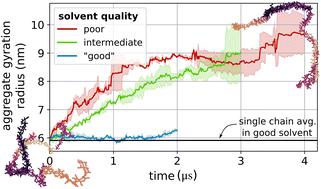Our official English website, www.x-mol.net, welcomes your
feedback! (Note: you will need to create a separate account there.)
Competing single-chain folding and multi-chain aggregation pathways control solution-phase aggregate morphology of organic semiconducting polymers
Nanoscale ( IF 5.8 ) Pub Date : 2022-11-24 , DOI: 10.1039/d2nr04750k Belinda J Boehm 1 , Christopher R McNeill 2 , David M Huang 1
Nanoscale ( IF 5.8 ) Pub Date : 2022-11-24 , DOI: 10.1039/d2nr04750k Belinda J Boehm 1 , Christopher R McNeill 2 , David M Huang 1
Affiliation

|
Understanding the solution-phase behaviour of organic semiconducting polymers is important for systematically improving the performance of devices based on solution-processed thin films of these molecules. Conventional polymer theory predicts that polymer conformations become more compact as solvent quality decreases, but recent experiments have shown the high-performance organic-semiconducting polymer P(NDI2OD-T2) to form extended rod-like aggregates much larger than a single chain in poor solvents, with the formation of these extended aggregates correlated with enhanced electron mobility in films deposited from these solutions. We explain the unexpected formation of extended aggregates using a novel coarse-grained simulation model of P(NDI2OD-T2) that we have developed to study the effect of solvent quality on its solution-phase behaviour. In poor solvents, we find that aggregation through only a few monomers gives effectively inseparable chains, leading to the formation of extended structures of partially overlapping chains via non-equilibrium assembly. This behaviour requires that multi-chain aggregation occurs faster than chain folding, which we show is the case for the chain lengths and concentrations shown experimentally to form rod-like aggregates. This kinetically controlled process introduces a dependence of aggregate structure on concentration, chain length, and chain flexibility, which we show is able to reconcile experimental findings and is generalisable to the solution-phase assembly of other semiflexible polymers.
中文翻译:

竞争性单链折叠和多链聚集途径控制有机半导体聚合物的溶液相聚集形态
了解有机半导体聚合物的溶液相行为对于系统地提高基于这些分子的溶液处理薄膜的器件性能非常重要。传统的聚合物理论预测聚合物构象随着溶剂质量的降低而变得更加紧凑,但最近的实验表明高性能有机半导体聚合物 P(NDI2OD-T2) 在不良溶剂中形成比单链大得多的延伸棒状聚集体,随着这些扩展聚集体的形成与从这些溶液沉积的薄膜中增强的电子迁移率相关。我们使用我们开发的一种新的 P(NDI2OD-T2) 粗粒度模拟模型来解释扩展聚集体的意外形成,该模型用于研究溶剂质量对其溶液相行为的影响。通过非平衡装配。这种行为要求多链聚集比链折叠发生得更快,我们展示的是实验显示的链长度和浓度形成棒状聚集体的情况。这种动力学控制的过程引入了聚集体结构对浓度、链长和链柔性的依赖性,我们证明它能够协调实验结果,并且可以推广到其他半柔性聚合物的溶液相组装。
更新日期:2022-11-24
中文翻译:

竞争性单链折叠和多链聚集途径控制有机半导体聚合物的溶液相聚集形态
了解有机半导体聚合物的溶液相行为对于系统地提高基于这些分子的溶液处理薄膜的器件性能非常重要。传统的聚合物理论预测聚合物构象随着溶剂质量的降低而变得更加紧凑,但最近的实验表明高性能有机半导体聚合物 P(NDI2OD-T2) 在不良溶剂中形成比单链大得多的延伸棒状聚集体,随着这些扩展聚集体的形成与从这些溶液沉积的薄膜中增强的电子迁移率相关。我们使用我们开发的一种新的 P(NDI2OD-T2) 粗粒度模拟模型来解释扩展聚集体的意外形成,该模型用于研究溶剂质量对其溶液相行为的影响。通过非平衡装配。这种行为要求多链聚集比链折叠发生得更快,我们展示的是实验显示的链长度和浓度形成棒状聚集体的情况。这种动力学控制的过程引入了聚集体结构对浓度、链长和链柔性的依赖性,我们证明它能够协调实验结果,并且可以推广到其他半柔性聚合物的溶液相组装。











































 京公网安备 11010802027423号
京公网安备 11010802027423号